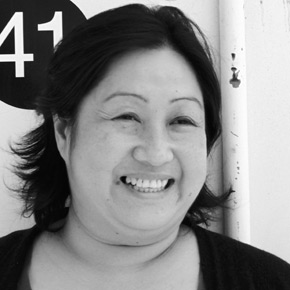07.02.14
One on One with Annie Chu
1. What’s your favorite activity to do during the weekend?
Looking at art – it keeps feeding my mind and helps connecting random bits of information into threads. Making those connections between experiences brings me a lot of pleasure. Visiting with friends, catching up and having serious and intimate conversations over wine.
2. What’s your favorite destination to visit?
I will always jump at the opportunity to spend a month in Paris at any time, but Helsinki is still on the top of my list – every turn of the eye reveals evidence of design thinking – from a door knob to a trash can. I also love the tension between the strict cultural expectations and the way creative folks break with those rules. The human connection with nature is strongly anchored in the building tradition – stone, wood and the meager available light, making designers do extraordinary things in the built environment to capture every last ray. The Russian melancholia you feel in the air is always challenged by small moves of defiance – the unique curves of Finnish design, the hidden sensuality below the surface. Its the land of Alvar Aalto, you will understand it when you are there.
3. What is your favorite iconic chair?
Gio Ponti’s 1957 Via Dezza Chair in the original Punteggiato velvet is one of my favorites – it exudes a quintessential Italian style with its silhouette and leaning back in contrast with the forward sloping armrest and the brass detailing. I think its one of those chairs that make you look good sitting in it.
4. What design style do you tend to gravitate towards or are you inspired by?
I am not sure if its a style, but after experimenting with formal exuberance in my youth, I have grown to appreciate material rich, thoughtful design with simpler geometry that anticipates the myriad of human experiences in the interior environment.
5. What inspired you into studying Mayan and Peruvian architecture for your fellowship?
Having been brought up in a rather “blade-runner” like cultural clash of East and West in colonial Hong Kong, and having been educated in the States, I was looking for an anchor to my design tendencies. Ironically I did not find classic Chinese architecture or the International Style home I grew up in simpatico; but my first visit to the courtyard at Uxmal in the Yucatan brought chills – something about the proportion of that space, the commanding and weighty object of the Pyramid of the Magicians and the anchor of the Palace of the Governors – it all clicked. Tod Williams and Billie Tsien gave me a monograph Megalith by Paul Caponigro which led to my interest in Incan architecture in Peru and my proposal to study Mayan and Incan works through the SOM traveling fellowship. The way that the Incas built their walls were so tectonically beautiful, Machu Picchu will always be an inspiration the way material, building and landscape work together.
6. Did your fellowship abroad change your view on design, architecture and /or aesthetics?
It strongly fused in my mind that interior, architecture and landscape is a continuum. Upon my return, the first interpretation of how to work with that was mostly formal – overlaid by my thesis work at Columbia, when students were reading Gilles Deleuze’s Thousand Plateaus and experimenting with folded geometries. That ran its course and I lost interest in the geometric and sculptural tendencies, looking for all the parts and language that contribute to the experiential outcome of any spatial design.
7. What would you say are the key elements that brings together architecture and interior architecture?
Recently I made a visit to the church at Le Corbuiser’s La Tourrette in Eveux, France. There in the space of uplifting proportions, weighty concrete carved for light and the bold presence of color, I wept, completely moved by that interior experience. My friend reminded me that the experiential was how I came to architecture, whether it was the Romanesque Cathedral in Rouen, Aalto’s Villa Mairea or La Tourrette – so I understood the fundamental architectural elements of wall, floor, roof, openings as the same vocabulary whether you are looking at architecture or interior from either lens.
Annie Chu will be honored at IIDA Southern California Chapter’s Leaders Breakfast, September 19th, 2014.
Jenneffer Burgos, IIDA, LEED AP, CDT
Gensler


